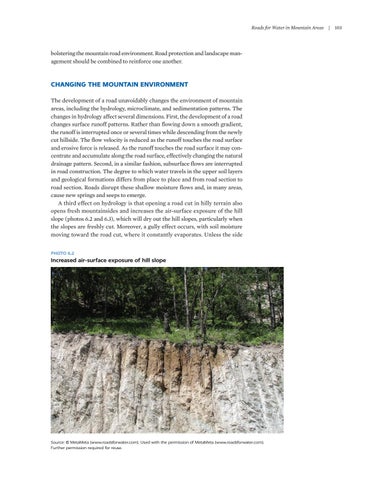Roads for Water in Mountain Areas | 103
bolstering the mountain road environment. Road protection and landscape management should be combined to reinforce one another.
CHANGING THE MOUNTAIN ENVIRONMENT The development of a road unavoidably changes the environment of mountain areas, including the hydrology, microclimate, and sedimentation patterns. The changes in hydrology affect several dimensions. First, the development of a road changes surface runoff patterns. Rather than flowing down a smooth gradient, the runoff is interrupted once or several times while descending from the newly cut hillside. The flow velocity is reduced as the runoff touches the road surface and erosive force is released. As the runoff touches the road surface it may concentrate and accumulate along the road surface, effectively changing the natural drainage pattern. Second, in a similar fashion, subsurface flows are interrupted in road construction. The degree to which water travels in the upper soil layers and geological formations differs from place to place and from road section to road section. Roads disrupt these shallow moisture flows and, in many areas, cause new springs and seeps to emerge. A third effect on hydrology is that opening a road cut in hilly terrain also opens fresh mountainsides and increases the air-surface exposure of the hill slope (photos 6.2 and 6.3), which will dry out the hill slopes, particularly when the slopes are freshly cut. Moreover, a gully effect occurs, with soil moisture moving toward the road cut, where it constantly evaporates. Unless the side PHOTO 6.2
Increased air-surface exposure of hill slope
Source: © MetaMeta (www.roadsforwater.com). Used with the permission of MetaMeta (www.roadsforwater.com). Further permission required for reuse.







































